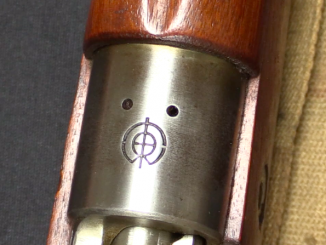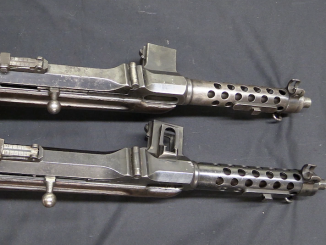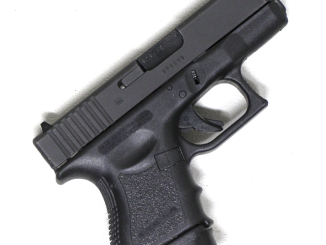The Steyr M1912, or Steyr Hahn (meaning “hammer”, to distinguish it from the striker-fired Steyr 1907) has a number of features that make it unusual among pistols today. It uses a fixed internal magazine fed via stripper clips, and a short recoil, rotating barrel locking system. Only a handful of other pistols have been made with rotating barrel systems, like the Steyr 1907, Beretta PX4, Savage 1907/1915, Mexican Obregon, GSh-18, Colt All-American 2000, MAB P-15, Boberg, and CZ-24. Rotating barrel pistols are often touted as being more accurate than others (generally the comparison is made against Browning-type tilting barrel designs), but this appears to be entirely theoretical. Any true advantage is small enough to be overridden by other factors.
Between 1912 and 1919 about 300,000 of these pistols were made for the Austrian military, which used them alongside Rast & Gasser M1898 revolvers. The 9mm Steyr cartridge they fire is roughly equivalent to 9mm Parabellum, despite having a longer case. Some 60,000 of the pistols were later converted to 9×19 after the Anschluss and used by the German military in WWII.




Ian; This is a very interesting video of the articulation of the barrel/slide interaction. The way you present the actual movements and interconnection of the components of the weapons you review is amazing. It makes things absolutely clear to the viewer and leaves no room for speculation on the part of the viewer. Thank you for your efforts and for maintaining this website.
The Steyr is externally similar to Colt M1900 automatic pistol. It also use similar cartridge (.38 ACP is metrically 9x23mm). The decision to copy external appearance and cartridge was decision of Austrian Military or Steyr factory?
“GSh-18”
The ГШ stands for Грязев and Шипунов, the designers of this automatic pistol, they also designed ГШ-23 auto-cannon working on Gast principle (so far I know uncommon outside Soviet Union)
Do you mean that the Gast principle autocannons are uncommon or the GSh-23 is uncommon outside the USSR/Russia? Because the GSh-23 was exported in later MiG-21 models to many countries and it’s still used by India, for example.
I mean that production (and designing) of the Gast principle autocannons outside Soviet Union is uncommon.
In each shot, it looks like the barrel bounces back and forth slightly just before locking on closing. If I’m not imagining this, then perhaps what is happening is the nose of the bullet is striking the edge of the chamber (feed ramp), the barrel bounces forward, hits some sort of forward stop, and then rebounds back before being driven forward again while locking.
I noticed that too.
Apparently result of clearances and elasticity. On subject of latter, I’d suggest to look a that subtle steel frame – it’s like a spring; slender and long.
You say that any accuracy gains from a rotating barrel would be small to be overridden by other factors, what are these other factors?
I have heard that fixed barrels are more accurate, such as a PM or a P7, but would the difference actually be noticeable?
Things like quality control on the barrel, condition of the crown, repeatability of the lockup, quality of the trigger pull, and so on.
You have in addition to what Ian mentioned also considerable torsion reaction. Locking surfaces stick together and absorb torsional stress until point of giving up.
This is not to say that every barrel rotary-lock design has to be prone to that behavior to same extent. Some later designs (notably Beretta PX4) are considerably stiffer mainly by wider slide / frame subassembly. Similar issue in tilting barrel designs is bending in vertical plane which is mitigated by large vertical section.
Hi Luke,
In terms of “accuracy” you need to think about the context.
If you have a lab technician bolting a pistol into a machine rest, and firing a group, than (assuming everything else is equal) a pistol which has its barrel rigidly fixed to the part that is fixed to the machine rest should give a tighter group than a pistol that has its barrel moving in some manner, between the shots, and this is what will appear in the test reports given to bureaucrats and will be repeated endlessly by unquestioning hagazine articles and on internet forums.
For parts to move freely, requires a clearence of at least around 0.003″. Careful use of tapers (e.g the bulged end of some autopistol barrels and the matching opening at the fromt of the slide) can result in metal to metal contact and closer repeatability when the parts are at rest, however some play between the moving parts is inevitable.
Now think of the same “fixed barrel” pistol being fired, with the sights being used to aim each shot. The sights are typically not both mounted on the barrel, but on the slide.
In this context, is the “fixed barrel” pistol likely to give any better grouping than a pistol where the barrel moves to lock into the slide?
probably not.
Is this difference of any consequence to the user of an auto pistol?
probably only if he is a well practiced target shooter, shooting in the conditions that he practices for. If he (or she) is full of adrenaline, fearing for his or her life, or even just an average weekend shooter, probably not.
I think this would beat a double-action revolver in terms of ammunition capacity and reload speed (though the latter item depends on how easily one handles strip chargers as opposed to individual cartridges or moon clips for a revolver). Can anyone add to this post, please?
I’d estimate it’s about as fast to reload this one with a stripper clip as it is to reload a swingout-cylinder or top-break revolver with a drum-type speedloader. It should beat a “strip” speedloader, but probably be no faster than half-moon clips. A full-moon clip would probably shade it a bit.
When I was instructing police small arms I learned from observation that the biggest slowdown in reloading was how each officer dealt with the empties. Some revolver shooters dumped them in their hand and stuck them in their pocket before commencing the reloading stroke. Others ejected the empties, but after using the speedloader took the time to return the empty speedloader to the belt holder.
With automatics, they tended to pull the magazine out and pocket it before beginning the reloading process.
All are legitimate techniques in competition, as in PPC. In actual service, they tend to get you killed.
I taught the students to eject the empties in a revolver or the empty magazine in an automatic, don’t worry about where they end up, and reload as fast as practicable consistent with their individual dexterity. I also taught that they should be drawing the reload as they fired the last shot, and to use the shooting hand for all manipulations of the weapon itself; the off hand would be fully occupied in doing the reload stroke.
After the speedloader’s cargo has been deposited in the revolver’s chambers, the speedloader should be jettisoned right then and there as part of the cylinder-closing stroke ending with the off hand back on the shooting hand in the Weaver stance.
Yes, some empty cartridges got stepped on, and some magazines and speedloaders got pretty beaten up (I recommended “range only” examples for each student).
But I wasn’t about to read in the paper about somebody I taught being found face down in an alley with a handful of either empty cartridges, an empty speedloader, or an empty pistol magazine.
I’m particular about that sort of thing.
cheers
eon
Good to read about your practical exposure, Eon.
Speaking of empties, they might be real risk while stepped on spilled on hard surface. In such case the fitness level of shooter might be paramount, one would guess. It,s like skating and shooting at the same time. One of those details we tend to forget.
Not to be picky…. “Hahn” is actually ‘rooster’ or ‘cock’ in more fitting term.
I like to see return to Austrian arms history.
According to John Walter, “Hahn” is accepted Germanic technical terminology for the hammer on a gun. Probably because of its motion’s resemblance to a pecking cock, as in the “snaphance”, which is an Anglicization of “schnapp-hahn”, “pecking cock”.
German speakers have been calling pistol hammers “cocks” for a very long time. That may be where our usage of “cock” to mean readying a weapon for firing came from, in fact.
cheers
eon
Very much like Czech equivalent – ‘kohout’ meaning same thing (sorry, bird).
To use the same word as what is used for a rooster when referring to the hammer is a pretty common thing in European gun terminology. In Hungarian, the term is “kakas” which, not surprisingly, means rooster.
In Russian it is called Курок, https://ru.wikipedia.org/wiki/Курок states that this name is derived from Polish kurek (which mean rooster). I suspect that this name traces back their origin to flint-lock era – see for example French 1777 Musket – the “rooster” hold flint in his “beak”.
Another great video! One of the biggest takeaways I get from these slow motion ones is how the action affects how the recoil impulse transmitted to the shooter. You can see the different reactions as the barrel comes to a stop versus when the slide does and how little there is until those happen in a recoil action.
Though robustly made, this model has some weakness at safety department; Some have not floating type firing pins, lowering the hammer on a chambered round is very dangerous, there is no half cock at notch all, if slipped when manually cocking, pistol goes bang, the manual safety locks straight the hammer and if the safety shaft is worn, the hammer may rotate beyond the cocking notch when applied, and goes bang when manual safety getting off.
Correction; …if the safety shaft is worn and trigger is pulled when safety actuated, the hammer may rotate beyond the cocking notch and goes bang when manual safety getting off.
I thought the safety-catch was the slide-lock! If the pistol slide is locked, you can’t shoot too well…
Manual safety can be applied at both hammer down and cocked positions as slightly camming back the same. When safety is applied at hammer down and slide at battery on position, slide is also locked since no hammer motion is possible, and when safety is applied with the slide at fully rear position, it also locks the slide at rear as permitting to load cartridges into the integral magazine one by one without using a clip. If compared this process with older Mauser C96, it is surely an improvement. But at that position if the trigger is pulled and then the safety is taken off to release the slide to chamber a round, and if the rotating shaft section of manual safety is worn, the pistol will discharge.
Do they rotate in the opposite direction to the rotation imparted on the bullet by the rifling out of interest?
It’s just I read a letter to G&A magazine which stated the direction of the rifling is opposite to that of the barrels threading holding it in the receiver, in order that it doesn’t unscrew itself when you fire “Equal, opposite or something”
If so I was wondering if the barrel was mounted in a manner that facilitated rotation and not rearward movement, would it rotate when you fired by that rather than the slide actuating it via it moving rearward with the barrel initially.
That GSh-18 Russian pistol only rotates slightly, maybe that’s how that works… The lugs don’t appear to be angled, in order to impart rotation by coming into contact with the slide for example.
Maybe not, interesting design anyway.
I have a question. I have the 1912 steyr. I’m not familiar with the gun. I didn’t know it had a built in magazine and tried to pull the clip from the bottom. Me thinking the clip was rusted in I use something to try to pull it out. It came out a little now it’s stopping the hammers from hitting. And when I pull the hammer back the clips moves out a little. What are some things I can do to try to fix it???
Hello Big Master in weapons that was and now is history,
I bacame the lucky owner of a Steyr Hahn 1912 a few month ago. I live in Denmark, witch is not the metropol of Ikealand but a land with very strict gun rules. This is not my problem but can you help me with the powder mesurement when reloading?
A big scandinavia fan
Birger Johansen
Copenhagen
Denmark
My research found many recommendations to use upper end 9mm parabellum loads in the 9mm Steyr (Whether with actual 9mm Steyr brass OR 38 Super Comp brass which is for all practical purposes dimensionally identical.) That is working well for me in my Chilean contract 1912!
Hallo David,
thanks a lot for the information. The Friend that are loading my ammution have now made
some shells for testing.
Again THANKS A LOT ! ! !
Birger Johansen